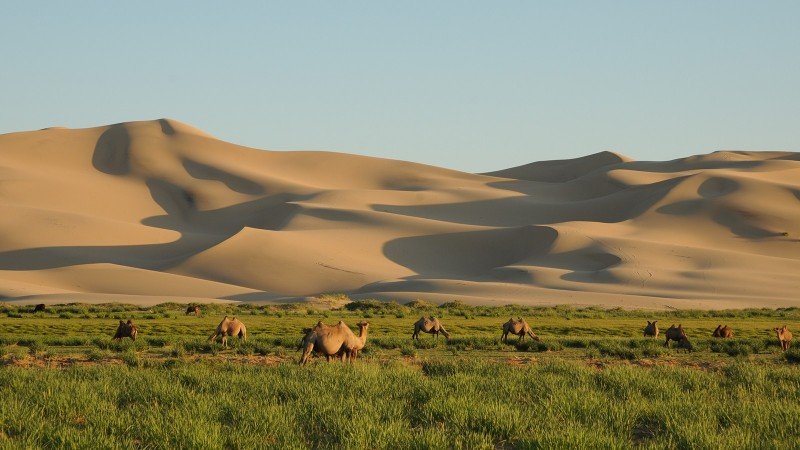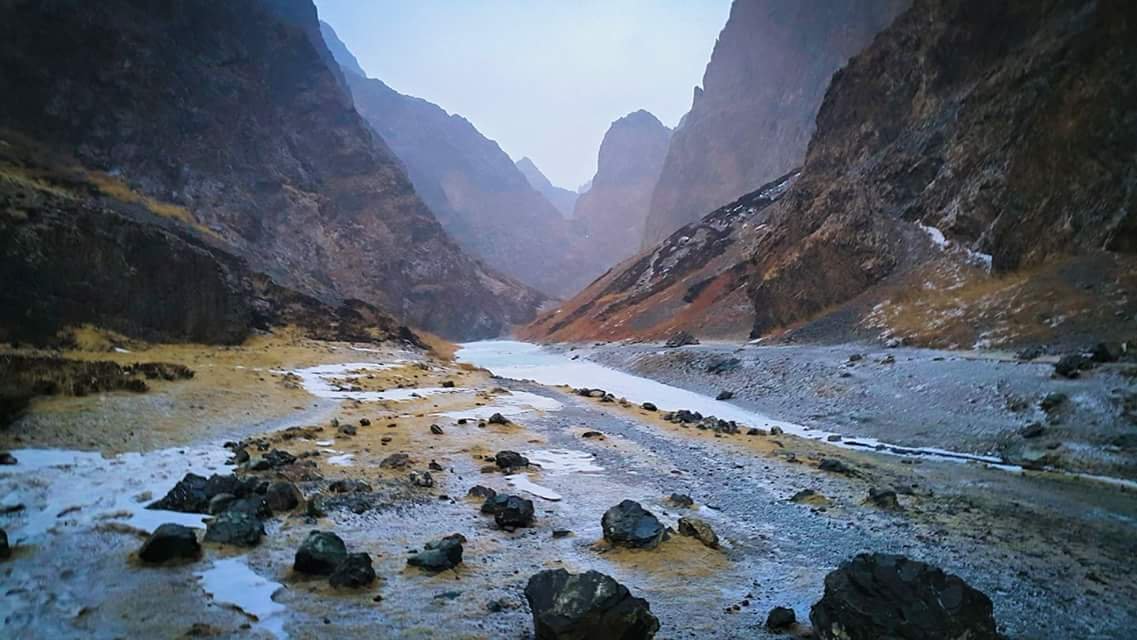The Gobi Desert
Mongolian Gobi desert is one of largest desert in world and a vast zone of desert steppe covering almost 30 percent Mongolia. The area is often imagined as lifeless. In reality, most of the Gobi desert is desert steppes, while sandy desert occupies only 3 percent of the total territory. Wild asses, camels, snow leopards, mountain sheep, and gazelles are bred, and different types of vegetation flourish here as well. Dinosaur skeletons and their petrified eggs have been preserved in the Gobi. The climate in the Gobi is extreme, with temperatures reaching 40 degrees Celsius in the summer and comparatively severe winters. The Great Gobi Reservation established in 1975 was designated by the United Nations as the fourth largest Biosphere Reserve in the world in 1991. This reservation is one and a half hour's travel by plane from Ulaanbaatar, located in foothills of the Altai Mountains at an altitude of 1521 meters above sea level. Two areas have been set paralleling the reserve. One, spreading over 44/9 hectares, claims the largest part of the Trans-Altai Gobi, the other, covering 881000 hectares is within the Dungar Gobi.


Yol valley
The Valley at the Yoliin Am, known as Eagle Valley whose depths support a huge block of glacial sheet ice even in the, hottest summer months, the ancient caves in the Zuun Saikhan Mountain Located 45 km from Dalanzadgad, in the Centre of South Gobi province, is called Yol Valley. The narrow Valley between high rock walls has breathtaking dramatic scenery, and no doubt is one of the most beautiful places in the country. During the rainy summers, hundreds of small waterfalls appear in the rocky walls. Camel and horse riding tours are available to the valley. Yoliin Am Canyon was already made a protected area In 1965 which eventually became part of Gurvan Saikhan National Park with a small 69 square kilometers (26,64 square miles) area around . Yoliin Am is located about 60 km (37 miles) Southwest Dalanzadgad, in the mountains of Züün Saikhan. The bearded vulture, Yol in Mongolian, gave its name to the Yoliin Am Valley, the Gorge of Bearded Vultures.At a height of 2500 metres, Yol Canyon forms a gorge that is so deep and so narrow which only possible two person pass in. The water forms four small waterfalls. Most of the places around the region gets the sun shine, but the canyon remains dark, almost impossible given sharp rising gorge through in middle part, a part of the river remains nearly all year long covered by a thick layer of ice.There most travelers have the chance see permanent glaciers, endemic plants, and rare animals such as Siberian ibex, wild sheep, or bearded vultures. Snow leopards and other predators can also be spotted also in the Yol Valley region.
Khongor sand dune
These dunes are located to the north of the Baruunsaikhan Mountains, and in the northern part of the Sevrei and Zuulun Mountains, about 200 kilometers west of Dalanzadgad in Sevrei soum. They extend for 185 kilometers and include dunes that can reach 20 meters in height. The sound produced by the masses of moving sand can be heard from a far.
The locals had given name of ”singing dunes” due to the noise made by the wind when it moves the sand. Beyond the dunes, the steppe extends as far as the eye can see.
Khongor dunes have a particular feature, because tthere is an impressing combination of colours. it has the golden yellow colour with a green and luxuriant vegetation band, delimited by a river : Khongoriin Gol. Supplied by subterranean sources, this little river flows along the dunes on a few kilometres, and forms an oasis in the middle of the dried landscape.


Bayan zag /Rich Saxaul/
Bayanzag is a Neolithic site where large dinosaur skeletons were discovered. These findings are now on show in the Natural History Museum. In the west it is better known as the Flaming cliffs, so named by explorer Roy Chapman Andrews. In the same location he also discovered petrified forests, remains of mammals, and in particular the skeleton of a hornless rhinoceros, one of the largest known mammals in the world. The name Bayanzag derives from a picturesque forest in the area. Bayanzag is a worldwide renowned place famous for dinosaur bones and eggs discovered here. Archeologists also claim the area has myriad of unearthed objects from the Stone Age.
#Mongolia travel agency
#Mongolia adventure tours
#Mongolia private tour
#Mongolia tour package
Orkhon Valley World heritage Site
Orkhon Valley is located in the North of the Ovorkhangai province, in the central part of Mongolia, about 360 kilometres (224 miles) Southeast of Ulaanbaator. With at the base of the Khangai mountain range which one of the three biggest mountain range, this site is now under protection of UNESCO from the 1992 covering 121.967 hectares along the Orkhon River.
The valley of the Orkhon River accommodates many historical and cultural vestiges, because it was one of main center of nomadic civilization since the prehistoric period.
The main monuments of the Orkhon Valley are as follows:
- The Orkhon monuments are early 8th-century Turkic memorials to Bilge Khan and Kul Tigin, the most impressive monuments from the nomadic Göktürk Empire. They were discovered by Russian archaeologists in 1889 and deciphered by Vilhelm Thomsen in 1893.
- Ruins of Khar Balgas, an 8th-century capital of the Uyghur Empire, which cover 50 square km and contain evidence of the palace, shops, temples, monasteries, etc.
- Ruins of Genghis Khan's capital Karakorum, which could have included the famed Xanadu palace.
- Erdene Zuu monastery is the first Buddhist monastery established in Mongolia. It was partly destroyed by Communist authorities in 1937-40.
- Tuvkhun Hermitage is another spectacular monastery, overlooking a hill at 2,600 meters above sea level. It, too, was almost totally destroyed by the Communists.
- Remains of the 13th and 14th century Mongol palace at Doit Hill, thought to be Ögedei Khan's residence.
- The Ulaan Tsutgalan waterfall, a waterfall, ten meters wide and twenty meters high, that can sometimes go dry or even freeze during winter.
Khuvsgul Lake
Blessed region with rich natural ecosystemLake Khuvsgul lies in the north-western side along with Russian Siberian border and 101km away from the nearest town called Murun. The lake has about 2760 square km and streches about 39.5km in wide and 133.4 kn long. It can go deep 262m. So it is the largest fresh water lake and second in by area. It is the second-most voluminous freshwater lake in Asia, and holds almost 70% of Mongolia's fresh water and 0.4% of all the fresh water in the world. It is estimated to have been created around 7 million years ago and now it is the lake fed by 46 springs and rivers on all sides. There are several mountain ranges whose the highest mountain is Buren-Haan (3,492 metres (11,457 feet)), with the peak towering north of the lake exactly on the Russian-Mongolian border.
In winter, the lake totally freezes and it is the great place for winter amusement celebration. Its water is potable without any treatment. The lake Khuvsgul is a habitat for nine different types of fish, such as The Siberian grayling, Euro-Asian perch, hurbot, lenok, and Siberian cat fish. The Park is home to a variety of wildlife such as ibex, argali, elk, wolf, wolverine, musk deer, brown bear, Siberian moose, and sable.
Consequently, the region boasts the single richest collection of deer stone, and burial mounds, and rock art in nearby areas.
Mongolia travel agency
The leading Mongolia travel agency is all set to bring the best Mongolia adventure tours for you. There are many places to explore and so many things to do in Mongolia. A Mongolia private tour announced by Nomadic Of Blue Sky can bring great help for you in this regard. Affordable Mongolia tour package is announced now. This tour package will bring a tailor made Mongolia private tour for you. opting for the Mongolia adventure tours can really help travelers to join some of the most fantastic events that only happen in Mongolia.
Tsagaan suvarga
Blessed region with rich natural ecosystemTsagaan Suvarga is located in Ulziit Soum, in the Dundgobi province. Tsagaan suvarga is the stunning and legendary cliffs formed by deposits of sediment from millions of years. This cliff indicates different times by its colored layers containing 10 million years of history. The stunning scenery makes awesome photos and a chance to explore the area through the gorges and canyons. It makes you feel like you are in the time of a Giant dinosaur. Tsagaan Suvarga is a beautiful photo shooting spot both day and night. There are some trails to hike down and up through the cliffs. Except for the cliffs, 50m-long Khevtee Bosoo Cave is worth a visit. People who have abundant time may spend a day exploring ancient rock drawing galleries in mountains located 32 km from Tsagaan Suvarga.




